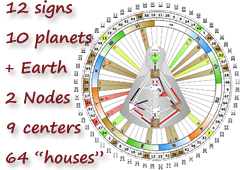Galy
Over 6 years ago, it must have been at the end of 2008, I came across a concept called human design. I suppose anyone can guess at the meaning of the phrase, but I’ll clarify it, just in case. It has to do with the structure or architecture of human beings. The term human matrix is also appropriate. Generally, I am a sworn sceptic when it comes to anything related to self-help programmes, whether they purport to make us richer, more successful or help us achieve anything we set our minds to. Which is why I initially regarded the human design concept with a pinch of salt, as bait for the naive. A mere couple of months later, however, I encountered this concept again. This time my curiousity was piqued and I decided to research the subject more thoroughly. I won’t delve into the origins of human design. I will only say that it was first introduced to the public 28 years ago, in 1986, by the Canadian Robert Alan Krakower, under the pseudonym Ra Uru Hu.
 The purpose of this article is not to rewrite what has already been explained in hundreds of other writings elsewhere. My aim is instead to put forward my personal views, conclusions and opinions on the topic. The sources on human design claim that the design or matrix of any human being is built on the date, time and place of their birth. So far it seems like yet another type of personalised horoscope, only using a different methodology and presentation. The only thing it has in common with traditional horoscopes is the circle of star signs and planets. As the technical side of human design is, in essence, astrological, it was fairly easy to grasp the way everything within this specific horoscope, called rave chart, is calculated and constructed. I found the Bulgarian translation of rave chart both surprising and thought-provoking. I must admit that only after a few months of active study and research I found myself utterly fascinated with the information we can draw from it, in addition to the standard astrological horoscope.
The purpose of this article is not to rewrite what has already been explained in hundreds of other writings elsewhere. My aim is instead to put forward my personal views, conclusions and opinions on the topic. The sources on human design claim that the design or matrix of any human being is built on the date, time and place of their birth. So far it seems like yet another type of personalised horoscope, only using a different methodology and presentation. The only thing it has in common with traditional horoscopes is the circle of star signs and planets. As the technical side of human design is, in essence, astrological, it was fairly easy to grasp the way everything within this specific horoscope, called rave chart, is calculated and constructed. I found the Bulgarian translation of rave chart both surprising and thought-provoking. I must admit that only after a few months of active study and research I found myself utterly fascinated with the information we can draw from it, in addition to the standard astrological horoscope.
Naturally, astrology and its predictive aspects, in particular, remain my absolute and indispensable favourites. But human design offered me something I’ve always felt astrology lacked, not because it is somehow imperfect, but simply because the missing element has so far been hidden, inaccessible, not sufficiently interpreted or explained to the public.
 Human design is the science of difference - the difference between individuals. Its concept holds that every human being on planet Earth operates and functions differently, in the physical, mental, psychological, intellectual and emotional sense of the word. Not one person can be entirely like another, not even twins. The concept covers another significant element which has been scarcely discussed so far – namely the way people are defined by one another, by the universally accepted binary concepts of right and wrong, of normal and abnormal, and by the way people’s personalities are moulded by a common model for development. Have you ever thought about the way ever since we are born we are being inculcated with the principles of self-improvement and becoming independent individuals, while at the same time we are being restricted by numerous rules.
Human design is the science of difference - the difference between individuals. Its concept holds that every human being on planet Earth operates and functions differently, in the physical, mental, psychological, intellectual and emotional sense of the word. Not one person can be entirely like another, not even twins. The concept covers another significant element which has been scarcely discussed so far – namely the way people are defined by one another, by the universally accepted binary concepts of right and wrong, of normal and abnormal, and by the way people’s personalities are moulded by a common model for development. Have you ever thought about the way ever since we are born we are being inculcated with the principles of self-improvement and becoming independent individuals, while at the same time we are being restricted by numerous rules.